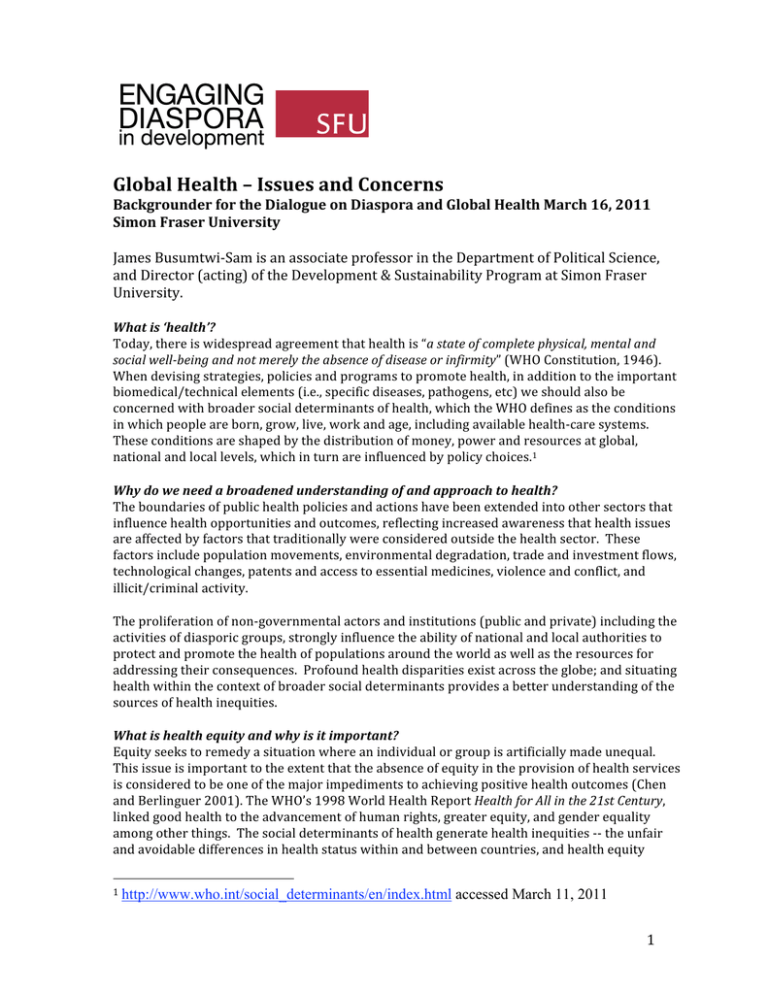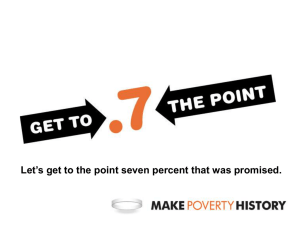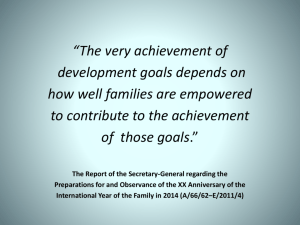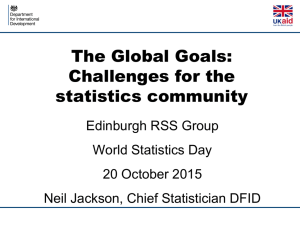Global Health – Issues and Concerns
advertisement

Global Health – Issues and Concerns Backgrounder for the Dialogue on Diaspora and Global Health March 16, 2011 Simon Fraser University James Busumtwi‐Sam is an associate professor in the Department of Political Science, and Director (acting) of the Development & Sustainability Program at Simon Fraser University. What is ‘health’? Today, there is widespread agreement that health is “a state of complete physical, mental and social well­being and not merely the absence of disease or infirmity” (WHO Constitution, 1946). When devising strategies, policies and programs to promote health, in addition to the important biomedical/technical elements (i.e., specific diseases, pathogens, etc) we should also be concerned with broader social determinants of health, which the WHO defines as the conditions in which people are born, grow, live, work and age, including available health‐care systems. These conditions are shaped by the distribution of money, power and resources at global, national and local levels, which in turn are influenced by policy choices.1 Why do we need a broadened understanding of and approach to health? The boundaries of public health policies and actions have been extended into other sectors that influence health opportunities and outcomes, reflecting increased awareness that health issues are affected by factors that traditionally were considered outside the health sector. These factors include population movements, environmental degradation, trade and investment flows, technological changes, patents and access to essential medicines, violence and conflict, and illicit/criminal activity. The proliferation of non‐governmental actors and institutions (public and private) including the activities of diasporic groups, strongly influence the ability of national and local authorities to protect and promote the health of populations around the world as well as the resources for addressing their consequences. Profound health disparities exist across the globe; and situating health within the context of broader social determinants provides a better understanding of the sources of health inequities. What is health equity and why is it important? Equity seeks to remedy a situation where an individual or group is artificially made unequal. This issue is important to the extent that the absence of equity in the provision of health services is considered to be one of the major impediments to achieving positive health outcomes (Chen and Berlinguer 2001). The WHO’s 1998 World Health Report Health for All in the 21st Century, linked good health to the advancement of human rights, greater equity, and gender equality among other things. The social determinants of health generate health inequities ‐‐ the unfair and avoidable differences in health status within and between countries, and health equity 1 http://www.who.int/social_determinants/en/index.html accessed March 11, 2011 1 requires the elimination of social barriers that produce disparities in health opportunities and outcomes (Janes 2006). We can think of health equity as comprising three components: vertical ­­ requiring fair mobilization of resources to pay for everyone’s health care; horizontal ­­ where the access to, use, and the quality and type of health services is based primarily on people’s needs; and the pooling of risk such that everyone, especially the most vulnerable, are protected from the economic consequences of illness (Janes 2006; Chen and Berlinguer 2001). An emphasis on health equity, then, implies that need ‐‐ not income/wealth, power and privilege ‐‐ should be the major determinant of health‐care access and ultimately of health outcomes. The WHO’s constitution declares that the enjoyment of the highest attainable standard of health is one of the fundamental rights of every human being. The notion of health care as a universal human entitlement the access to which should not be determined by particular economic circumstances was cemented in the 1978 Alma Ata Declaration. 2 The profound disparities in health opportunities and outcomes across the world today, however, indicate quite a divergence between recognizing a ‘right to health’ in principle and in practice. Globally, the disparities are most acute between the North and South. As Kofi Annan, the then UN Secretary‐General noted in an address to the World Health Assembly in 2001, “the biggest enemy of health in the developing world is poverty.” In countries classified as ‘least developed’ or ‘low income’, for example, life expectancy is just 49 years, and one in ten children does not reach their first birthday. In high‐income countries, by contrast, the average life expectancy is 77 years and the infant mortality rate is six per 1000 live births. There is a ‘vicious cycle’ in the relationship between poverty and ill‐health ‐‐ poverty contributes to ill‐health and ill‐health leads to poverty. A recent report by the WHO and World Bank Dying for Change: Poor People’s Experience of Health and Ill­Health, notes that poverty creates ill‐health because poor people tend to live in environments that make them sick, without decent shelter, clean water or adequate sanitation. Poverty creates hunger, which in turn leaves people vulnerable to disease. Poverty denies people access to reliable health services and affordable medicines, and the illiteracy associated with poverty leaves people poorly informed about health risks. It is within this context that the deprivations, exclusions and inequities associated with poverty and inequalities globally have been highlighted as one of the biggest obstacles to promoting health globally. What are some of the main challenges to achieving more equitable healthcare? The 1978 Alma‐Ata Declaration sought to achieve ‘health for all by the year 2000’ through participatory, community‐focused comprehensive primary health care (PHC) within the broader context of multi‐sectoral development (WHO 1978; Thomas & Weber 2000). Needless to say, the goals of PHC have not been achieved. As the WHO itself acknowledges, while there have been improvements in areas such as childhood immunization, there have been setbacks to providing equitable access to essential health care worldwide. Health system constraints 2 WHO 1978, http://www.who.int/hpr/NPH/docs/declaration_almaata.pdf 2 including financial barriers and health worker shortages, combined with challenges such as the HIV epidemic, have hampered progress towards achieving health for all. 3 The reality is that in the 30 plus years since the Alma Ata declaration, the equity and community‐ based (bottom‐up) emphasis of PHC has been eroded in favour of ‘efficiency’ cost‐utility (top‐ down) reforms based on neoliberal market economic principles (the so‐called ‘Washington Consensus’ favouring privatization, deregulation, etc). The original framework for this neoliberal approach was outlined in the World Bank’s 1993 World Health Report Investing in Health, and embraced by other major Multilateral Financial Institutions (MFIs) including the IMF, and bilateral donors (Thomas and Weber 2004). The new approach, ‘Health Sector Reform’, made little use of PHC principles and focused on the reduction of government services in favour of private sector delivery of healthcare services. User fees, cost recovery, private health insurance, and public–private partnership became the focus for healthcare service delivery. Overall, healthcare was seen in terms of economic benefits that improved health delivers (i.e., human capital for development), rather than as a consequence and fruit of development. To be sure, the major MFIs and bilateral donors have made some modifications to this model. Some analysts talk of a ‘socially‐inclusive’ neo‐liberalism (the so‐called ‘post‐Washington Consensus’) emerging at the end of the 1990s and into the new millennium, entailing increased attention to poverty and improving other social variables especially health and education (Porter and Craig 2004). This new version sought to soften (but not eliminate) the emphasis on market‐driven economic growth in the original Washington Consensus. The MFIs and bilateral donors made ‘poverty reduction’ a cornerstone of their lending programs, and created new lending programs to accommodate higher pro‐poor public expenditure in the South. It was within the context of this new agenda that the Millennium Development Goals (MDGs) were adopted in 2000. What do the Millennium Development Goals say about health? The United Nations Millennium Declaration was signed in September 2000, which led to the adoption of the MDGs ­­ a set of eight goals and a number of numerical targets to be achieved by 2015 or earlier. MDG 1: eradicate extreme poverty and hunger MDG 2: Achieve Universal Primary Education MDG 3: promote gender equality and empower women MDG 4: reduce child mortality MDG 5: improve maternal health MDG 6: combat HIV/AIDS, malaria and other diseases MDG 7: ensure environmental sustainability MDG 8: develop a global partnership for development Health is at the heart of the MDGs – recognition that health is central to the global agenda of reducing poverty as well as an important measure of human well‐being. Health is the explicit focus of three of the eight goals, and health issues are acknowledged as central to the attainment of other key goals including eradicating extreme poverty and hunger, gender equality, and 3 http://www.who.int/bulletin/primary_health_care_series/en/index.html accessed March 11, 2011). 3 environmental sustainability. The MDGs provide important benchmarks for measuring global progress on key development outcomes and focus attention on the enormous challenges in the poorest countries. The global financial and economic crisis that began in 2008 has had a negative impact on progress towards achieving the MDGs, and the ability to recover will vary across countries and regions. According to the World Bank (2010), while the longer‐term effects of the global economic crisis are unknown, by the end of 2010 – just five years to the target year of 2015 – lack of progress was evident in several key MDG indicators in poorer countries including health, nutrition, and poverty‐reduction indicators. Some key shortcomings and challenges to achieving the health‐related goals of the MDGs include: Maternal mortality has shown the least progress of all the health‐related MDGs, declining by only 6 per cent in the developing regions (from 480 maternal deaths per 100,000 births in 1990 to 450 deaths in 2005) (United Nations 2009). Child mortality declined in the developing regions from 103 deaths per 1,000 live births in 1990 to 74 in 2007, but even the faster annual decline now underway is insufficient to reach the goal of a two‐thirds reduction by 2015 (United Nations 2009). Shortage of health workers: The shortage of health workers reached 4.3 million in 2006, including 2.4 million doctors, nurses and midwives. Among the 57 countries facing a critical shortage of doctors and nurses, 36 were in sub‐Saharan Africa (WHO 2006). Shortages are more critical in rural areas. Nearly half of the world population lives in rural areas, but only 38 per cent of the world’s nurses and less than 25 per cent of doctors work in rural areas (WHO 2009). Emigration of health professionals affects health service delivery and is contributing to the shortages of health workers in some developing countries. Small developing countries are disproportionally affected by emigration of health workers. (OECD 2006). Donor funding for reproductive health on a per woman basis has fallen by over 50 per cent in 42 of the 49 least developed countries since the mid‐1990s. This decline has contributed to shortages in supplies and services, which in turn keep unmet need high (United Nations 2010). What can diaspora do to improve health opportunities and outcomes? Diasporic contributions to health can be situated within the context of debates over health equity and the challenges to realizing the health‐related MDGs. The World Health Organization has sought to renew the emphasis on primary health care in its 2008 Report Primary Health Care: Now More Than Ever4 Five key elements are central to achieving this goal: reducing exclusion and social disparities in health (universal coverage reforms); organizing health services around people's needs and expectations (service delivery reforms); integrating health into all sectors (public policy reforms); pursuing collaborative models of policy dialogue (leadership reforms); and increasing stakeholder participation.5 4 http://www.who.int/whr/2008/en/index.html 5 (http://www.who.int/topics/primary_health_care/en/ accessed March 11, 2011) 4 Questions for further exploration: In what ways can the diaspora help achieve these goals? What are the main areas in which the diaspora have a comparative advantage or unique opportunity to engage with communities in their places of origin/attachment to help in the ‘development’ process, and how can they organize to increase the impact they will have (conversely, what are the constraints they face)? What are the opportunities/insights for successive generations to participate in the development process in their places of origin/attachment? Do subsequent diasporic generations lose some of the socio‐cultural context that might provide them greater or lesser insight into their places of origin/attachment? Is the perspective they bring significantly different and if so, how? How do diaspora bring about positive ‘systemic’ changes in their places of origin/attachment? How might the diaspora accelerate more substantive or fundamental changes than are associated with small, discrete projects such as improving sanitation and access to safe drinking water in a single village? What opportunities are there for diaspora to engage in advocacy work, knowledge creation, and capacity building? Are there any positive changes that diasporic researchers bring about through their studies and proposals? In what ways are these experiences and interchanges transforming health practices and understandings in the North? (i.e., what is the looping effect?) 5 References Chen, L. C. and Berlinguer, G. (2001) “Health Equity in a Globalizing World,” in T. Evans, Whitehead, M., Diderichsen, F., Bhuiva, A. and Wirth, M. (eds) Challenging Inequities in Health: From Ethics to Action (New York: Oxford University Press) 35‐/44. Janes, Craig R. O. Chuluundor, C. E. Hillard, K. Rak and K. Janchiv, (2006) “Poor Medicine for Poor People? Assessing the Impact of Neoliberal Reform on Health Care Equity in a Post‐socialist Context,” Global Public Health, 2006 1(1): 5‐/30 Organization for Economic Co‐Operation and Development (2006), International Migration Outlook: SOPEMI 2007 Edition. Paris: OECD. Porter, D and D. Craig, (2004). “The Third Way and the Third World: Poverty Reduction and Social Inclusion in the rise of ‘Inclusive’ Liberalism,” Review of International Political Economy, 11, 2 (2004): 387–423. Thomas, Caroline and Martin Weber, “The Politics of Global Health Governance: Whatever Happened to “Health for All by the Year 2000”? Global Governance 10, 2 (2004) 187–205 United Nations (2009), Millennium Development Goals Report 2009 (United Nations Publication, No E.09.I.12) United Nations (2010), Department of Economic and Social Affairs, Population Division, Accelerating achievement of the MDGs by lowering fertility: Overcoming the challenges of high population growth in the least developed countries. August 2010 No. 2010/5 World Bank (1993), World Development Report 1993: Investing in Health. New York: Oxford University Press World Bank (2010), Global Monitoring Report 2010: The MDGs After the Crisis, Washington DC: World Bank, 2010) World Health Organization (1998), World Health Report 1998: Health for All in the 21st Century Geneva: WHO World Health Organization (2006), World Health Report 2006: Working Together for Health. Geneva: WHO. World Health Organization (2008) World Health Report: Primary Health Care (Now More Than Ever) Geneva: WHO World Health Organization (2009), Monitoring the Geographical Distribution of the Health Workforce in Rural and Underserved Areas. Spotlight on Health Workforce Statistics, Issue 8, October 2009. Geneva: WHO. WHO and World Bank, Dying for Change: Poor People’s Experience of Health and Ill­Health 6




